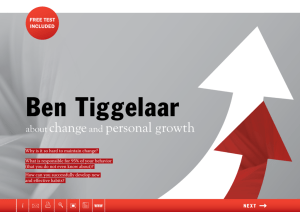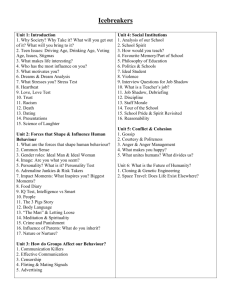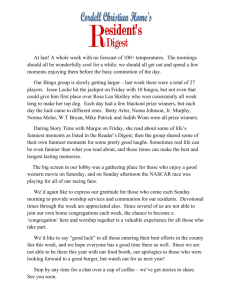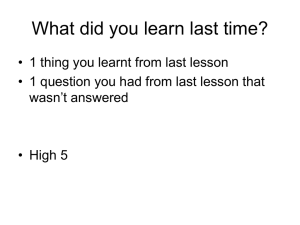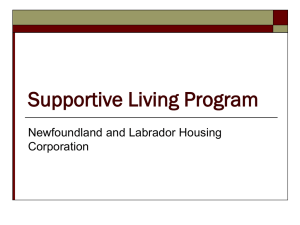The summary of Can Do!
advertisement
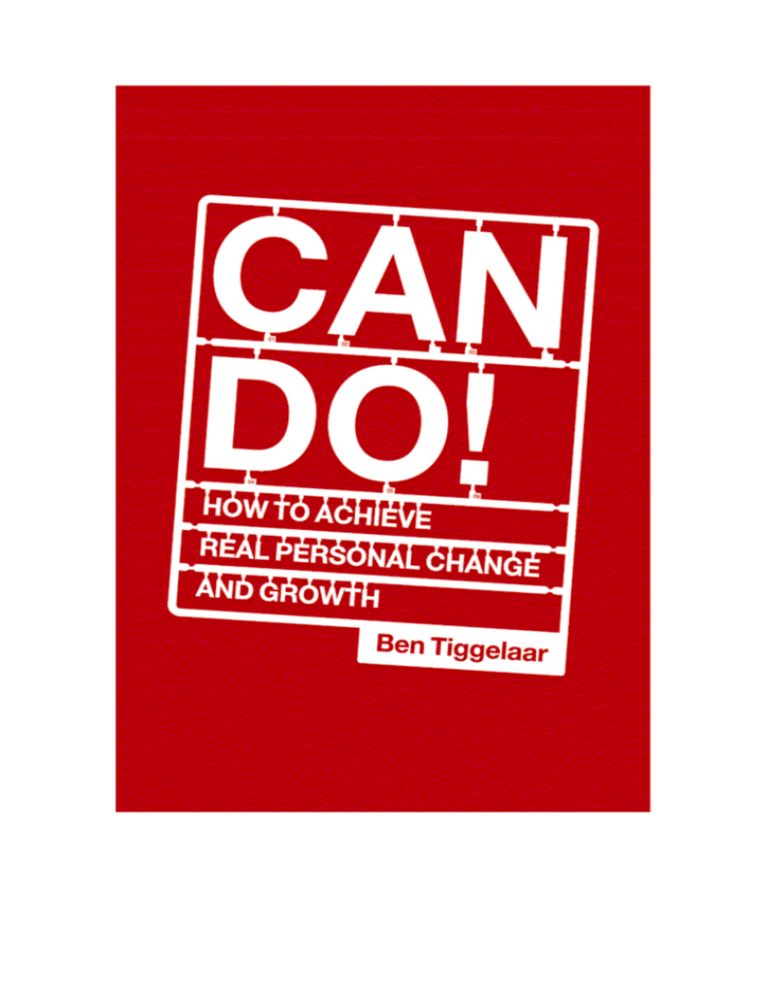
Why change? Change is an inevitable part of our lives. And in business, it is an indispensable element wrote Warren Bennis, the American management guru. People and change go hand in hand. Our society is filled with challenges like prosperous well being, and individualization. In business we face subjects such as globalization, increasing competition and a big need of entrepreneurship and innovation. And on a personal level we are worried more than ever about our health, our relationships, our work, and our personal growth. In all these changes our behavior is a leading factor—our own behavior in particular. Behavior is the link between planning and getting results. And in all cases, you need to manage your own behavior before you can have an impact on others. Impacting someone else’s behavior starts with your own habits and behavior; at home, on the job, and in all other aspects of society. Sometimes we literally get tired of all the changes that take place. And of course, not every change is an improvement. But for every improvement change is needed. You can’t get around this fact. That is why it is important to have insight into your own behavior, and that of others, and to have knowledge of effective techniques for goal oriented change and influence. Change is difficult 80% of all people that begin with personal change, fall back into old habits. For change in businesses, the same numbers occur. How come change ends in disappointment so often? Here are some answers from behavioral science. 1. Too often we focus on the results and too little on behavior. We know our desired outcome but don’t define the daily steps we have to take. 2. We focus on conscious, planned behavior, which forms merely 5% of our total behavior. 95% of our behavior is unconscious, automatic, and is triggered by our surroundings. 3. Every change means risk of loss, at least that of old certainties. We know from research that loss touches us, and impacts us twice as hard as when we gain. This is what causes us to think twice before we think about changing. 4. We are impatient, and work unstructured. But real change needs time. People go through different phases before they are ready for real change. Conscious, planned behavior Unconscious, automatic behavior We have two kinds of behavior: Conscious, planned behavior (5%) Unconscious, automatic behavior (95%) How do we change? Dream, dare, do! The great aim of education is not knowledge but action, said the British philosopher Herbert Spencer. Lots of changes do fail—this is a fact. But there are people who are able to maintain lasting, positive change. The techniques used by people that successfully change are divided into three steps: Dream, Dare, Do. In the first step, Dream, formulate goal-oriented and concrete behavior intentions. The second step, Dare, thoroughly prepare yourself for the most difficult changes. Get prepared for the difficult moments to come, as you try to change behavioral patterns. The third step is Do, begin to act on the desired behavior, to measure it, and if needed, reward the achievements and keep it up. With these three steps, we combine proven insights with regard to our conscious planned behavior and our unconscious behavior. When you have merely good intentions but you apply no change to your daily environment, the success in changing is minimal. You need to work at both: your intentions and making sure your surroundings will not slow you down, but will advance your changing. Step 1: Dream We can dream from our negative experiences, our "no" perspective. These negative experiences show us the need to change. We can also dream from our positive experiences, our "yes" perspective. These form the cornerstone for positive change and growth. Often we pay more attention to the negative side of things. It makes us passive and heavy-hearted. By putting our focus on the things at which we excel, we mobilize our power. The secret to steering oneself toward change and growth is about recognizing our exceptional good moments and to systematically work to create more of them. It’s not about becoming somebody else. It is about becoming more like you, the same person you are in those good moments. Therefore it is necessary to pinpoint the behavior that contributes to those positive moments: measurable, active and personal (M.A.P.) YES NO We spend too much time in our lives thinking about our "no" perspective and too little about our "yes" perspective. Step 2: Dare Most people that start their journey of changing, often fall back into old patterns. But this doesn’t just happen. These setbacks mostly surface in times of crisis, some of which we could see coming way ahead. For example, when you experience others disapproving of you, or the moments when you are too busy with other things. Stress and exhaustion especially lead people to fall back into old, ineffective habits. Luckily there is something we can do about this. Research shows when we actively anticipate these moments of crisis it is proven very effective. The chance at perseverance increases with a factor of three or four. How can one persevere in these difficult moments? Three techniques: 1. One needs to remember the intended change all the time, also during crises. You need to remind yourself powerfully when it is needed the most. You can do this by putting up notes using stickies, putting a note on the refrigerator, or making notes in your agenda. 2. Rewards help. You can keep up with making changes by compensating the moments of crisis. Overcome short-term frustrations by compensating these moments. 3. Countering is the third technique proven to be effective when battling moments of crisis. Actively speak, move, think, and feel to defend yourself against falling back into automatism. Also, taking a time-out helps. It is most important that you define an alternative behavior for the automatic old pattern. Step 3: Do! People learn most quickly through direct feedback. That is why we need to monitor, measure and jot down our new behavior from the start. Note: we need to measure the behavior, not the results. Often the results come later on in the process. A few tips on “Doing”: 1. We can prevent ourselves from postponing by preparing our start. When it isn’t “automatically” fun to start our new behavior, make it fun by rewarding, treating yourself. 2. Don’t think in terms of success or failure, but think in terms of learning. When you find your goals truly important, your can fail, but you will learn. 3. We often need to measure our new behavior for quite a while to make these new behaviors automatic behaviors, and decrease setbacks. A year or longer is often needed. 4. Successful change works very stimulating. The one who gets motivated using the three steps-- dream, dare, do-- will eventually get more of a grip on life. 1. fir s ever t listen to y con versa others b efore tion I sta mo rt tu we th fr to ta lk, in sa su 2. ev e score minu ry mornin tes o f exe g before rcise 11.0 0am mo inimu tu m of we 10 th fr s a 3. on su ly score really allow th ings impo in m rtant y age to m nda e mo that are tu we th fr sa su score Keep the lists to measure your behavior clearly and simply. About the Author Ben Tiggelaar is a leading consultant and trainer who specialises in personal and corporate change. He has individual and corporate clients all over the world, and regularly speaks and runs seminars on change. www.bentiggelaar.com Comments from readers and reviewers: "This book is the perfect companion to ‘The 7 Habits.’ I finally understand how I can actually achieve the change I desire." "At last - somebody who goes a couple of steps further than most change gurus … Ben Tiggelaar reveals the pain of personal behavioural change in an entertaining way." "This book helped me to understand the behaviour of others, and it gave me a great deal of insight into my own behaviour." "Ben Tiggelaar is truly able to inspire people. He combines theory and practice in a highly professional way." Can Do! How to achieve real personal change and growth QUESTION: What factors influence our behaviour in personal and corporate changes? QUESTION: How can we break through old, ineffective habits and replace them with new, effective behaviour? QUESTION: What structural measures can be taken to ensure that changes within organizations are more successful? In this book, top trainer Ben Tiggelaar answers these questions and many more about change and growth. This book is extremely practical, amusing, and accessible, and at the same time straightforward, thought-provoking, and based on scientific research. CYAN BOOKS 119 Wardour Street London W1F 0UW

